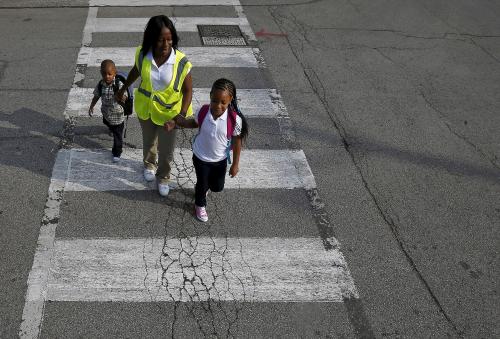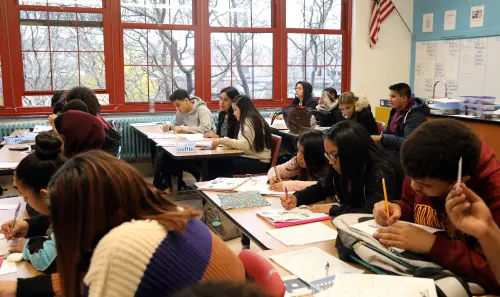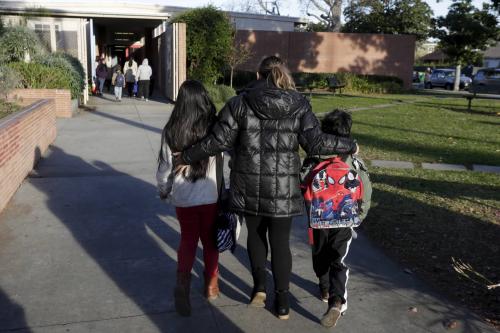The U.S. public school system is characterized by large funding differences across districts, but what about differences in school spending within districts? Generally, districts have discretion with respect to how they allocate resources to specific schools. In recent research (working paper available here), we evaluate the conditions under which districts under-allocate resources to poor, black, or Hispanic students.
We collect the most recently available school finance data from the Civil Rights Data Collection (CRDC) for the 2011-12 and 2013-14 academic years. These data tell us how much each U.S. public school spent on personnel (teachers and staff) salaries. Average CRDC-reported personnel expenditures are about two-thirds of instructional expenditures, a measure that is commonly used in education finance.
The measure of inequality we use accounts for both a school’s funding level and the way that students are sorted among schools within a district. We capture spending inequalities for three groups of students: poor and non-poor, black and white, and Hispanic and white. Some examples illustrated below can help clarify how inequality is measured. Consider a hypothetical district with two schools of equal size:
- Example 1: In this district, most of the poor students attend a school with an average spending of $4,000 and most of the non-poor students attend a school with an average spending of $6,000. We would record that the poor students in this district receive a smaller share of school resources than the non-poor students.
- Example 2: In another district, average spending in the two schools is again $4,000 and $6,000, but poor and non-poor students are evenly distributed between them. Here, we would record that poor and non-poor students have equal shares of school resources, even though there is spending variation between schools.
- Example 3: In a third district, most of the poor students attend one school and most of the non-poor another. But in each school, average spending is $5,000. In this case, we would still record that the poor and non-poor shares of school resources are even, even though there is sorting between schools.
These examples demonstrate that the measure records inequalities only when there is between-school segregation and spending differences between schools within a district. With this measure of inequality, we can say whether district spending is pro-poor, pro-black, or pro-Hispanic to the extent that the shares of spending on poor, black, and Hispanic students is greater than the shares of spending on non-poor and white students.
Several interesting patterns emerge from our analysis of the data.
We find that, on average, poor and minority students receive between 1-2 percent more resources than non-poor or white students in their districts, equivalent to about $65 per pupil. Although average within-district spending on poor and minority students is positive, not all districts spend more money on these students—in the most unequal districts, they receive between $300-$500 less per pupil.
By way of comparison, we also constructed an analogous measure of spending inequalities across districts. Because districts vary in how much resources they can raise locally, we expected to see more inequality across districts than within them. Yet, we were surprised to see that average levels and variation in spending inequality between districts is nearly identical to the within-district inequalities. Thus, within-district distributions appear to be far more important than previously thought.
We then investigated whether district characteristics—for example, district income, segregation, income inequality, and demographic composition—were predictive of whether districts over- or under-allocated resources to poor and minority students.
Because most districts allocate resources with little oversight, we expected that district characteristics indicative of uneven parental socio-economic and political status would predict greater spending inequality. For example, we hypothesized that wealthier districts would under-allocate resources to poor and minority students. We reasoned that parents with greater resources could more effectively navigate the local political system, making it easier to secure a greater share of school spending for their children. Reasoning similarly, we also expected to find that in districts with greater income inequality and segregation, poor and minority students would receive a smaller share of school resources.
In many cases, however, we find just the opposite:
- In richer districts, poor and Hispanic students receive more school resources, relative to their non-poor and white peers in the same districts.
- Districts with more school segregation—whether socioeconomic or racial—tend to spend more on poor and minority students relative to non-poor and white students.
- Black and Hispanic students receive relatively fewer resources in districts where black or Hispanic family income is more equal to (or even higher than) white family income.
While we were surprised by these relationships, some of our findings also conformed to our expectations. In districts with higher family incomes and a larger share of white students—where smaller black populations may exert less political influence—black students receive a smaller share of resources.
Taken together, the results of our research provide new insights into the level and distribution of intra-district spending inequality. Our analysis also sheds light on the types of districts that under-spend on poor and minority students, helping us understand the underlying demographic, economic, and political processes that account for these discrepancies.
Provided a continued federal commitment to data collection and transparency, we will undoubtedly learn more moving forward. The Every Student Succeeds Act (ESSA) represents just such a commitment to collecting vital information about schools. Among other things, ESSA requires districts to compile biannual school-level finance data—information that can be used to ensure that all students receive their fair share of resources.







Commentary
Do school districts spend less money on poor and minority students?
May 25, 2017